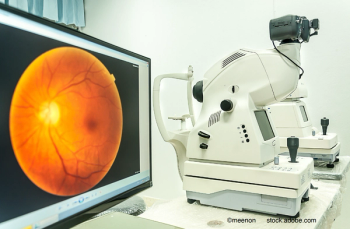
Early detection of CNV in second eye key to improving outcomes
Early detection and anti-VEGF treatment of choroidal neovascularization (CNV) in the second eye leads to better mean final visual acuity (VA) with fewer injections at 1 year.
Early detection and anti-vascular endothelial growth factor (VEGF) treatment of choroidal neovascularization (CNV) in the second eye leads to better mean final visual acuity (VA) with fewer injections at 1 year, according to a study presented during ARVO 2020 by Katherine Holekamp (John Burroughs School, St. Louis).
Baseline VA is one of the best predictors of ultimate visual outcomes with anti-VEGF injections in neovascular age-related macular degeneration (AMD),1 and these findings validate previous work that earlier detection leads to better outcomes.
Retrospective study design
Titled “Early Detection of Second Eye CNV in nAMD Leads to Better Visual Acuity and Fewer Injections at Month 12,” the study was a retrospective chart review of patients with nAMD from a single retinal practice between June and July 2019.
To be included, patients had to have CNV in their first eye diagnosed and treated by a single surgeon, have monthly optical coherence tomography (OCT) performed on both eyes while treating the first eye, and have second eye CNV diagnosed while treating the first eye.
A total of 50 patients met this inclusion criteria with an average age of 80; 64% were female.
All patients received three monthly anti-VEGF injections followed by monthly follow-up visits and additional injections as needed through 1 year.
Primary endpoints were mean VA at diagnosis at 1 year, as well as the mean number of injections in the same time period.
Results: Better visual acuity, fewer injections
Mean visual acuity at the time of CNV diagnosis in the first and second eyes were 20/68 and 20/30, respectively (p < 0.05).
At month 12, vision improved in the first eye to 20/52 and vision in the second eye remained stable at 20/30.
The second eye also received fewer anti-VEGF injections (5.72 injections vs. 6.25 injections; p = 0.5), although the injection difference was not statistically significant.
“It is important to note that the second eye vision remained better than the first eye vision throughout the study, with a statistically significant difference and a p-value of 0.017,” Ms. Holekamp said.
Figure 1 illustrates the time and months between baseline and final vision against the mean LogMAR vision for all 50 patients.
“This graph shows that over a period of 12 months, first eye visual acuity improved. Interestingly, the second eye visual acuity worsened slightly. However, second eye visual acuity is clearly better than first eye visual acuity.”
The results bore out with further follow-up as well. At 59 months of follow-up in the first eye, mean visual acuity was 20/63 after a median 18 injections. At mean second eye follow-up of 38 months, visual acuity declined to 20/40 after an average of 11 injections.
“At complete follow-up, second eye visual acuity remains better than first eye visual acuity, with a statistically significant difference. These results are consistent with results at month 12,” Ms. Holekamp said. “Our results are consistent with our hypothesis, that if the second eye’s involvement with CNV is detected earlier, then anti-VEGF treatment results in better mean final visual acuity. While visual acuity in the first eye improved with treatment, and second eye visual acuity declined slightly through month 12, second eye visual acuity outcomes were always superior. The importance of early detection of neovascular AMD is validated in this study.”
Frequent OCT imaging needed for success
Ms. Holekamp mentioned several limitations of the study, including the retrospective design, small case series, and lack of information on the specific anti-VEGF agent used.
However, she noted that the results are consistent with previous work, including the RENO study, which she said was presented at the ASRS and ARVO Annual Meetings in 2019.2,3
RENO was a retrospective study of 46 eyes from a single practice. At the time of CNV diagnosis, VA was 20/63 and 20/63 +2 for the first and second eyes, respectively.
Second eye CNV was detected when the first eye was being treated, and visual outcomes were ultimately better but with the same number of injections.
“One big difference between the RENO study and our study is that the RENO study did not catch a second eye involvement as early as this study,” Ms. Holekamp said. “Our practitioner treated patients monthly, emphasizing the importance of frequent OCTs of the fellow eyes to detect early conversion to CNV.”
Ms. Holekamp believes that frequent OCTs on high-risk, asymptomatic fellow eyes is key to earlier diagnosis and better outcomes in this patient population, but acknowledged that monthly imaging is burdensome for patients.
Home monitoring devices may reduce that burden once approved, she said.
References
1. Ying GS, Maguire MG, Daniel E, et al. Association of Baseline Characteristics and Early Vision Response with 2-Year Vision Outcomes in the Comparison of AMD Treatments Trials (CATT). Ophthalmology 2015;122(12):2523-31 e1.
2. Dang J, Khanani AM, Gahn G ,et al. Efficacy of the treat-and-extend regimen in the management of neovascular age-rerlated macular degeneration: 5-year results of the RENO Study. Presented at: Association for Research in Vision and Ophthalmology. April 28-May 2, 2019: Vancouver, Canada.
3. Mojumder N, Dang JM, Khanani AM, et al. Visual acuity outcomes of fellow eyes treated for new onset age-related macular degeneration in patients in the RENO study. Presented at: American Society for Retina Specialists 37th annual meeting. July 26-30, 2019;Chicago, IL.
Newsletter
Keep your retina practice on the forefront—subscribe for expert analysis and emerging trends in retinal disease management.
















































